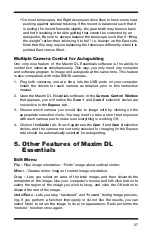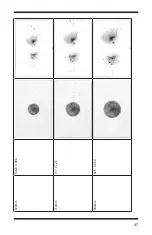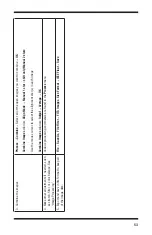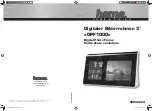
40
5. If the star drifts north, the telescope mount is pointing too far west. If the
star drifts south, the telescope mount is pointing too far east. Determine
which way the star drifted and make the appropriate correction to the azi-
muth position of the mount. Rotate the entire mount (and tripod) slightly
east or west as needed or use the azimuth adjustment knobs (if your mount
has them) to make fine adjustments to the mount’s position.
6. Next, point the telescope at a bright star near the eastern horizon and near
the celestial equator (Dec. = 0).
7. Let the telescope track for at least five minutes, and the star should begin
to drift north or south.
8. If the star drifts south, the telescope mount is pointed too low. If the star
drifts north the telescope mount is pointed too high. Observe the drift and
make the appropriate correction to the mount’s altitude (or latitude); most
mounts have some sort of fine adjustment for this.
Repeat the entire procedure until the star does not drift significantly north or
south in the eyepiece. When this is accomplished, you are very accurately
polar aligned, and should be able to produce good (unguided) images of up to
several minutes long, assuming the mount’s drives track well with little periodic
error.
Choosing a Site for astro-imaging
Once you have a focused image, you may find your image shifting and washed
out. This can be caused by many environmental factors. Poor seeing (move-
ment of molecules in the air, such as heat rising) and poor transparency (mois-
ture, smoke, or other sky contaminants) will all serve to reduce image quality.
That is why most major astronomical telescopes are on high mountains in thin
air, to get above much of the transparency and seeing problems. Also, wind
will move your telescope and affect images. Your eyes viewing through an
eyepiece can change slightly to compensate for disturbances like these, but
the camera can not. Keep these factors in mind when choosing an observing
site for astronomical imaging.
For the best astro-images, we recommend finding a location with dry air, some
altitude, and away from city or streetlights. Even a nearby hilltop in the coun-
tryside can provide better viewing conditions than many convenient backyard
locations.
using Focal reducers and Barlow lenses
Focal reducers and barlow lenses change the effective focal length of a tele-
scope. These lenses are inserted between the camera and telescope when
imaging to change image scale.
Focal reducers serve to decrease the focal length of your telescope. This
increases the field of view seen by the camera (decreases camera magnifi-
cation). This can be very useful for obtaining images of wide-field deep sky
















































